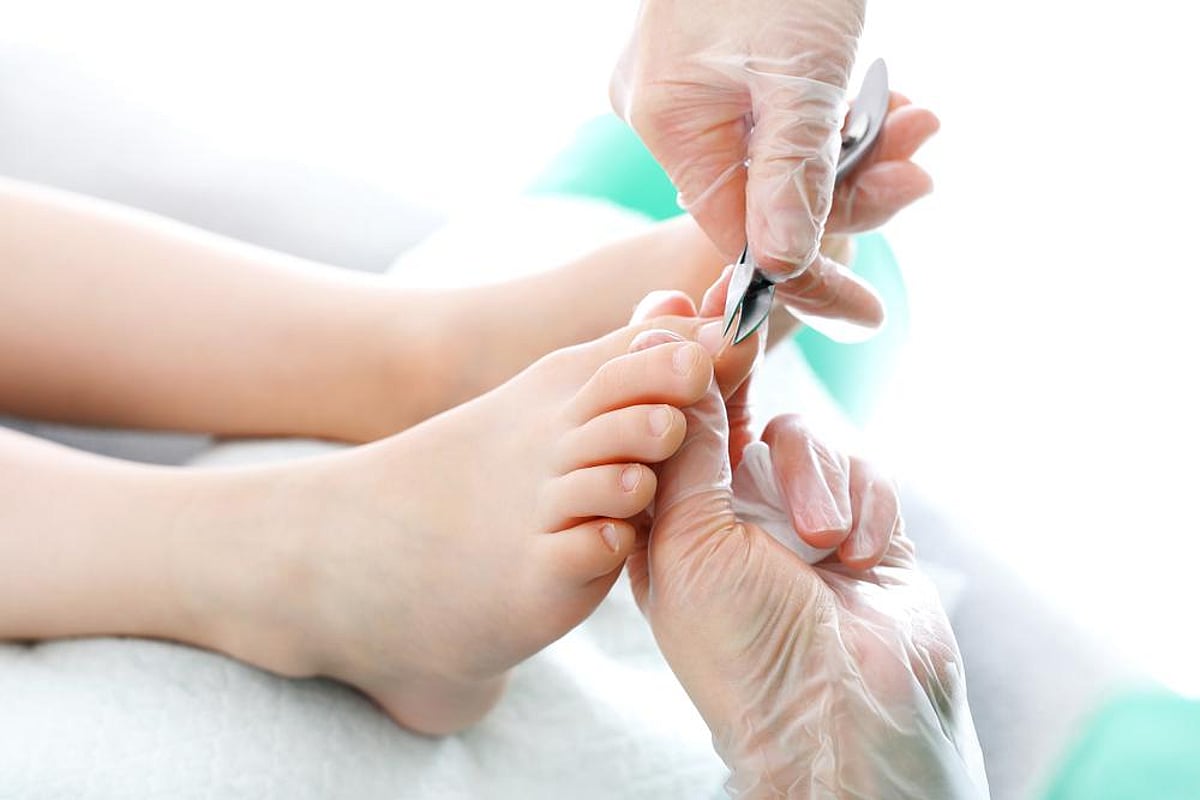Ingrown Toenail

If my child has an ingrown toenail, how do I recognize it?
You'll usually notice a toenail that's pressing or growing into the skin. Big toes are most likely to develop ingrown toenails, but the problem can show up on any toe. A typical early sign is redness or swelling in the skin at the edge of a nail; the nail may also be digging into your child's toe rather than growing straight. This ingrown nail can become infected, after which you'll see a blister containing clear or yellowish fluid. If the blister breaks, you might notice a discharge. The swelling or redness may also increase as the nail grows.
Are ingrown toenails painful?
Yes, as your child will let you know. An ingrown toenail is tender and can be quite painful, especially when rubbed by a shoe or a tight sock. In fact, complaints about this are often the first indication of an ingrown nail. If your child says his toe or foot hurts, or if he limps or grimaces when he walks, check those toenails. It's also important to regularly inspect the toenails of kids who are too young to walk or talk.
How should I treat my child's ingrown toenail?
Soak the foot in warm -- not hot -- soapy water for about 15 to 20 minutes two or three times a day. Afterwards dry it and apply a dab of over-the-counter antibiotic ointment or cream to the problem area. If you can, gently lift the toenail and pack a small amount of sterile cotton or gauze between the nail and the skin; use only enough to raise the nail slightly. (Replace the cotton several times a day.) Have your child wear loose-fitting shoes or sandals until the nail is healed. In many cases, an ingrown toenail will improve in a few days once you start taking these steps.
How can I prevent ingrown toenails?
Some children seem to be genetically predisposed to them. Most ingrown toenails, however, are caused by poorly fitting shoes or by nails that are cut too short or too rounded. Shoes that pinch, especially in the front, can compress the toes and lead to ingrown nails. Even too-tight socks can push your child's nails into his toes. With little feet that are growing fast, it's important to check the fit of the shoes often.
Ingrown toenails may also result from nails being allowed to grow too long; these can break off when your child is playing or when they get caught in his sock. When the nail breaks or tears, it may be too short and thus grow "in" to the side of the toe instead of "out." To prevent this problem, be sure to cut the toenails before they become long enough to break or tear on their own.
One caution: Toenails should be cut straight across -- not in a rounded shape -- with a nail clipper rather than scissors; always leave a little of the white showing at the end of the nail. If your child is squeamish about having his toenails cut, do it while he's sleeping.
When should I see a doctor?
If an ingrown toenail doesn't improve after about a week of home treatment, see your pediatrician. If there is redness, swelling, or an infection around the toenail, he will probably treat it with an oral antibiotic. Sometimes, it's also necessary to cut the offending nail away from the skin or remove a portion of it.
Further Resources
Pantell, Robert H. M.D., James F. Fries M.D., and Donald M. Vickery M.D. Taking Care of Your Child: A Parent's Illustrated Guide to Complete Medical Care, Eighth Edition. Da Capo Lifelong Books.
References
Your Podiatric Physician Talks About Nail Problems, American Podiatric Medical Association, Bethesda, Maryland. http://www.apma.org
Ingrown Nail, The PDR Encyclopedia of Medical Care, Medical Economics Company, Inc.
American Academy of Family Physicians, FamilyDoctor.org. Ingrown Toenails. http://familydoctor.org/online/famdocen/home/common/skin/disorders/208.html
Mayo Clinic. Ingrown Toenails. M http://www.mayoclinic.com/health/ingrown-toenails/DS00111
Related Posts
WHO Approves First Long-Acting Device to Shield Women From HIV
WEDNESDAY, Dec. 1, 2021 (HealthDay News) -- With HIV a continuing threat to...
Orgasm’s Key Role in Women’s Sexual Satisfaction
WEDNESDAY, April 13, 2022 (HealthDay News) -- The more orgasms you have, the...
Swimmer’s Ear
What is swimmer's ear?It's an ear infection that kids and adults commonly get by...
